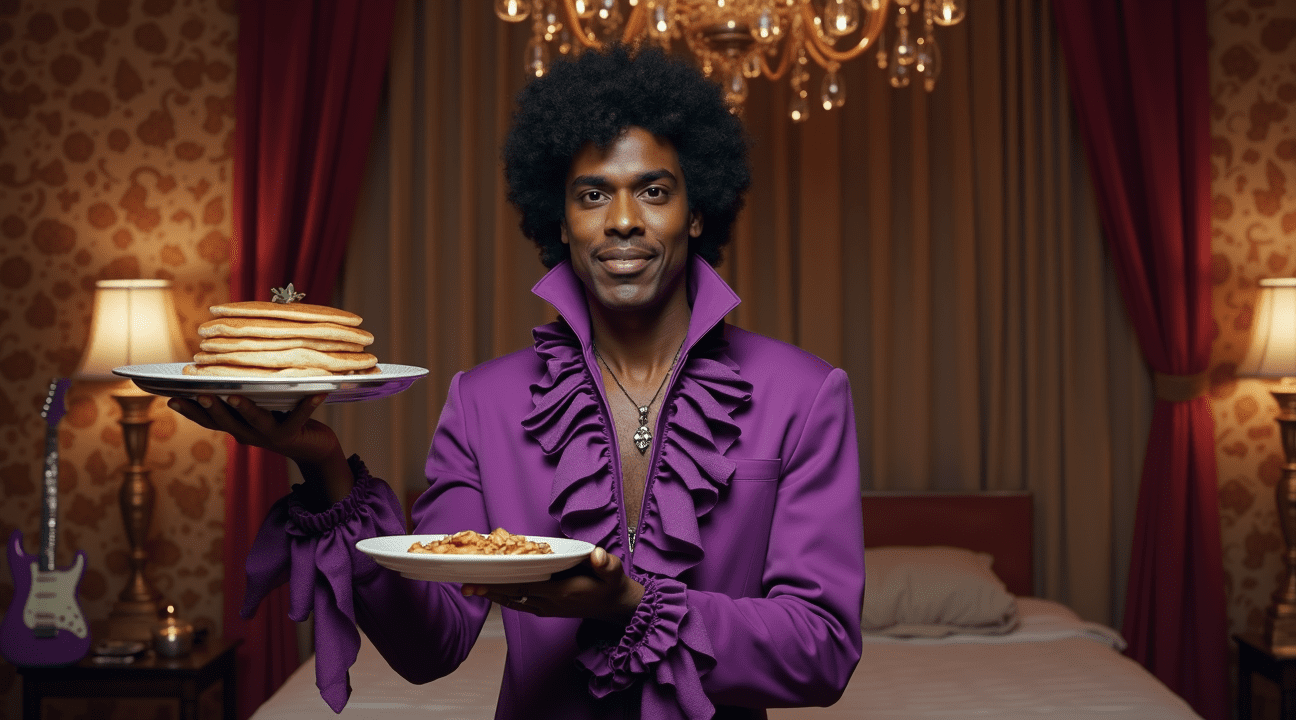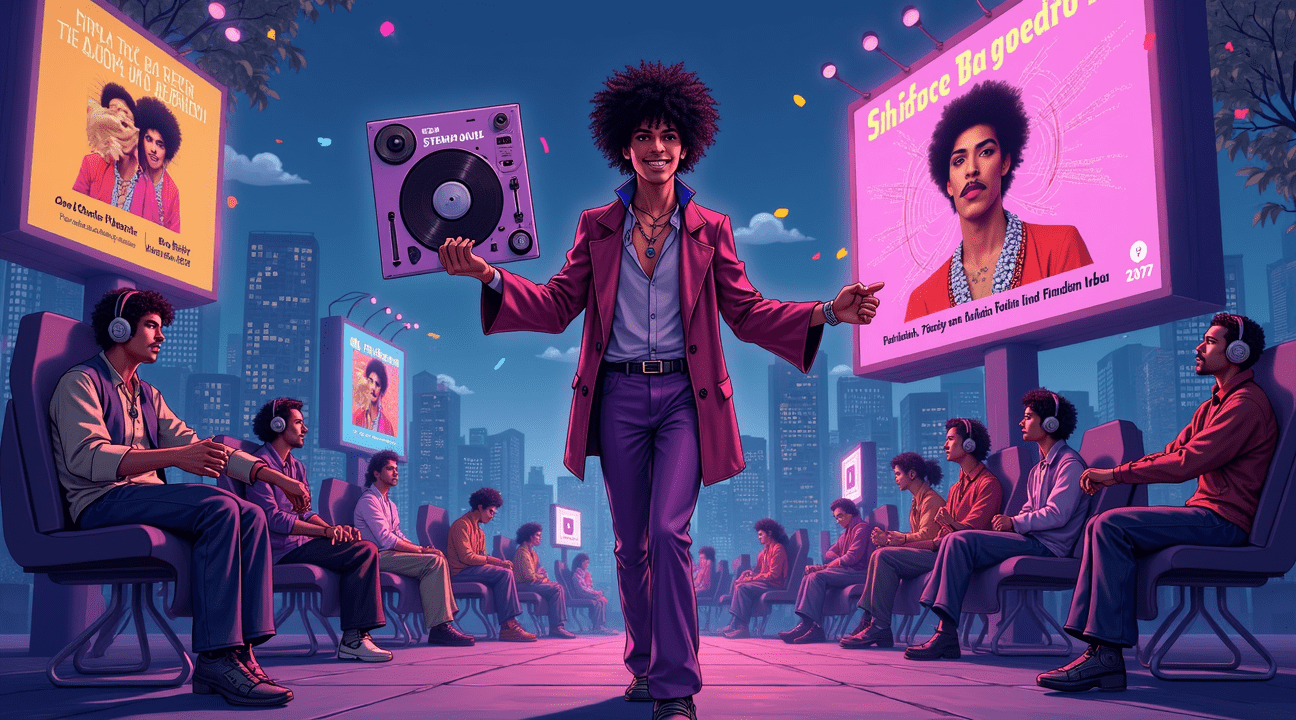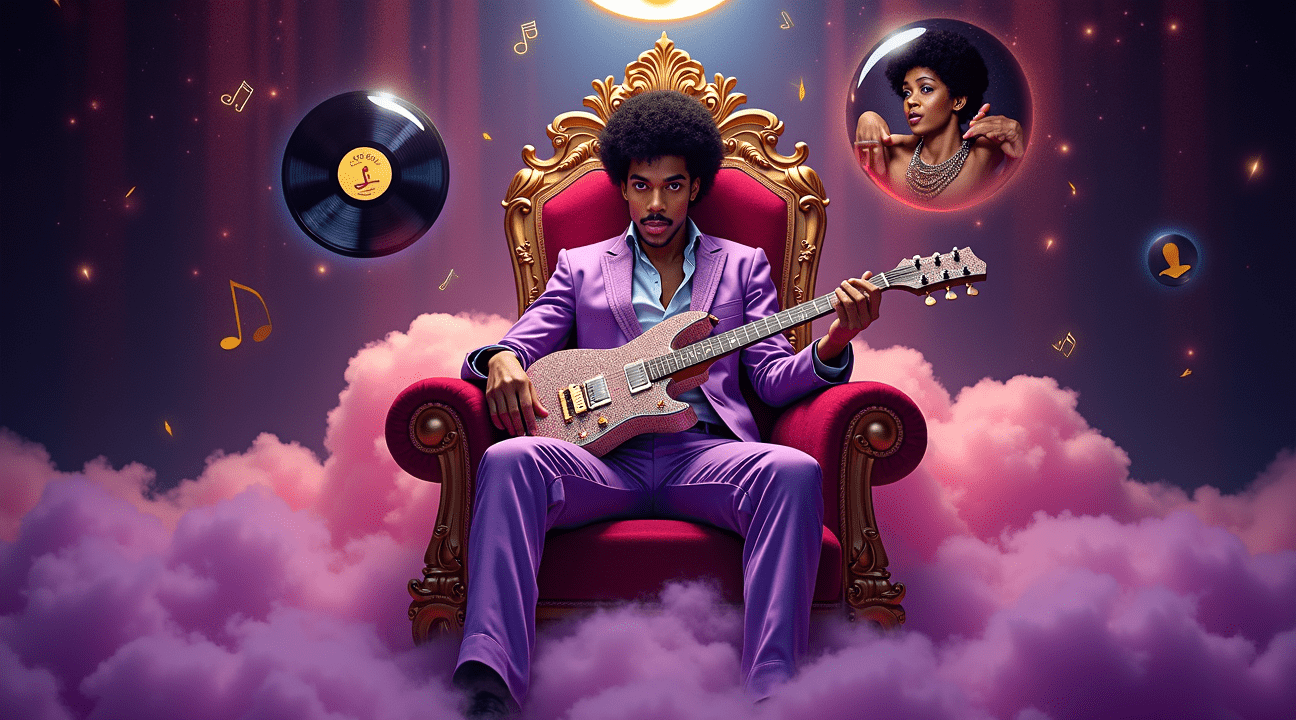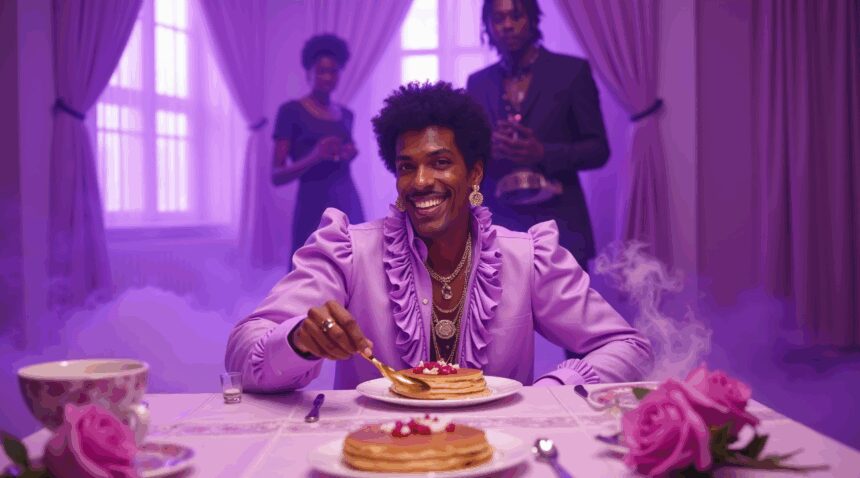Prince demonstrated his extraordinary sense of humor and cultural intelligence when he chose Dave Chappelle’s legendary comedy sketch portrayal for his 2013 single “Breakfast Can Wait” cover art.
This surprising artistic choice transformed a beloved television parody into official album artwork, showcasing Prince’s confidence in his legacy and openness to embrace how others interpreted his Purple Rain-era persona.
Key Takeaways
- Prince used Dave Chappelle’s famous sketch of him serving pancakes as the official cover art for “Breakfast Can Wait,” released in 2013 through his independent platforms.
- The single achieved notable chart success, particularly in Belgium where it reached No. 38 on the Urban chart and No. 80 on the Bubbling Under chart.
- Chappelle couldn’t legally challenge Prince’s use of the image since it showed the comedian dressed as Prince himself, creating a humorous circular logic situation.
- The track was later included on Prince’s 2014 album Art Official Age, which he released simultaneously with PLECTRUMELECTRUM as part of an innovative dual-album strategy.
- This collaboration represents Prince’s evolution as an artist comfortable with pop culture references and his ability to merge high art with comedy while maintaining complete creative control.
Dave Chappelle’s Prince Sketch Becomes Actual Album Cover in 2013
Prince demonstrated his sense of humor and pop culture awareness when he chose an unexpected image for his 2013 single “Breakfast Can Wait.” The Purple One selected a photo of comedian Dave Chappelle dressed as Prince from the Purple Rain era, complete with the iconic ruffled shirt and makeup, serving pancakes. This artwork choice directly referenced one of the most memorable sketches from Chappelle’s Show, creating a surreal moment where comedy met music history.
The Release and Re-release Strategy
Prince initially released “Breakfast Can Wait” on February 5, 2013, exclusively through 3rdEyeGirl.com. The artist then re-released the single on August 17, 2013, via 3rdEyeTunes.com, expanding its availability to a broader audience. This dual-release approach reflected Prince’s independent distribution strategy during this period, utilizing his own platforms to maintain creative control over his music and presentation.
Chappelle’s Humorous Response
Dave Chappelle’s reaction to discovering his image on Prince’s album cover proved as entertaining as the original sketch itself. The comedian acknowledged the situation with characteristic wit, noting the absurdity of the legal implications. Chappelle pointed out that he couldn’t sue Prince for using a picture of himself dressed as Prince, creating a perfect circular logic that highlighted the playful nature of the entire situation.
The choice to use this particular image wasn’t random. Prince’s decision reflected his awareness of how Chappelle’s sketch had become ingrained in popular culture. The Dave Chappelle’s iconic moment portraying Prince had resonated with audiences far beyond the original Comedy Central broadcast, creating a lasting piece of entertainment history that Prince himself chose to embrace rather than dismiss.
This album cover represents more than just a humorous nod to comedy. Prince’s willingness to use Chappelle’s interpretation of him demonstrates the artist’s confidence in his own legacy and his ability to find humor in how others perceived him. Rather than taking offense at the satirical portrayal, Prince turned it into album art, effectively making Chappelle’s comedy sketch part of his official discography.
The artwork choice also speaks to Prince’s broader relationship with popular culture throughout his career. Known for his serious artistic pursuits and sometimes enigmatic public persona, this moment revealed a lighter side that fans rarely witnessed. The pancake-serving image became an instant talking point, generating buzz for the single while simultaneously celebrating the comedy that inspired it.
Prince’s decision to feature the Chappelle image created a unique convergence between music and comedy cultures. The artwork transformed a television sketch into a permanent piece of music history, ensuring that Chappelle’s portrayal would be forever linked to Prince’s actual musical output. This cross-pollination between entertainment mediums demonstrated how modern pop culture references can transcend their original contexts and become part of larger artistic statements.
The “Breakfast Can Wait” cover art stands as a testament to Prince’s evolved perspective on his public image. Throughout his career, he maintained strict control over his likeness and artistic presentation. However, by 2013, he’d reached a point where he could appreciate and even celebrate how others interpreted his persona, turning what could have been seen as mockery into an official part of his artistic legacy.
This collaboration between Prince and Chappelle’s image, though indirect, created a memorable moment in entertainment history. The single cover became a conversation starter that bridged generational gaps, appealing to both Prince’s longtime fans and younger audiences familiar with Chappelle’s comedy. The artwork effectively captured the playful spirit of both artists while creating something entirely new from their combined cultural impact.
https://www.youtube.com/watch?v=GcsnlZIRKQA

Chart Success and Commercial Performance of the Single
The single’s commercial journey demonstrated Prince’s ability to capture both mainstream and niche markets during his later career period. Chart performance revealed interesting regional preferences, with Belgium emerging as a particularly receptive market for this particular release.
International Chart Performance
Belgium proved to be the strongest market for the single, achieving notable positions across multiple chart systems. The track reached No. 80 on Belgium’s Ultratip Bubbling Under Flanders chart, which tracks emerging songs before they enter the main charts. More significantly, it climbed to No. 38 on Belgium Urban (Ultratop Flanders), indicating strong appeal within urban music circles.
These chart positions reflected the song’s crossover potential between mainstream and specialized audiences. The urban chart success particularly highlighted Prince’s continued relevance in contemporary music scenes, even as musical landscapes shifted around him. Belgium’s dual chart recognition suggested the track resonated with both radio programmers and core urban music fans.
The commercial strategy expanded beyond the initial single release with The Breakfast Experience remix EP, which arrived on October 24, 2013. This extended play represented Prince’s growing engagement with digital distribution methods and remix culture. The timing of this release, coming months after the original single, demonstrated strategic planning to maintain momentum and explore different musical interpretations.
Prince’s approach to remixes during this period marked a significant shift from his earlier career stance on alternative versions of his work. The Breakfast Experience EP showcased various producers’ takes on the original composition, creating fresh entry points for different listener demographics. Each remix brought distinct production styles while maintaining the core elements that made the original compelling.
The digital release strategy reflected broader industry trends toward streaming and downloadable content. Prince, despite his complex relationship with digital platforms throughout his career, recognized the importance of these distribution channels for reaching contemporary audiences. This particular release cycle demonstrated his willingness to adapt traditional album promotion methods to modern consumption patterns.
Commercial performance metrics from this era often differed significantly from traditional album sales figures. Streaming numbers, digital downloads, and playlist inclusions began carrying equal weight with physical sales and radio airplay.
The single’s success in these newer metrics helped establish its cultural impact beyond conventional chart positions. The connection between the single’s success and Dave Chappelle’s iconic moment on the album cover created additional marketing opportunities. This visual association helped bridge entertainment mediums, attracting attention from comedy fans who might not typically engage with Prince’s music. The crossover appeal contributed to sustained interest in both the single and the broader album project.
International chart success, particularly in Belgium, often served as a testing ground for broader European acceptance. The positive reception in Belgian markets frequently translated to increased attention from other European territories, though specific chart data from additional countries remains limited for this release.
The remix EP’s commercial strategy also reflected Prince’s understanding of fan engagement in the digital age. By offering multiple versions of the same composition, he provided dedicated listeners with reasons to revisit and re-purchase content. This approach:
- Maximized revenue potential
- Encouraged continual engagement
- Appealed to devoted collectors and fans
Marketing campaigns surrounding the single leveraged both traditional music industry promotion and newer social media strategies. The visual impact of the album cover, combined with strategic playlist placements and targeted digital advertising, helped the single maintain visibility across multiple platforms simultaneously.
The chart performance ultimately validated Prince’s decision to experiment with contemporary promotional methods while maintaining his artistic integrity. The Belgium success demonstrated that innovative approaches to single releases could still generate meaningful commercial results, even in increasingly fragmented music markets.

From Single to Album: “Art Official Age” Release Strategy
Prince transformed the standalone single “Breakfast Can Wait” into a cornerstone track for his larger artistic vision with Art Official Age, released on September 30, 2014. This strategic decision showcased his ability to weave individual releases into comprehensive album projects that told broader musical stories.
The album marked a significant moment in Prince’s later career, featuring extensive collaborations that demonstrated his continued evolution as an artist. Art Official Age included contributions from various musicians and producers, creating a diverse sonic landscape that bridged his classic sound with contemporary elements. Prince’s decision to include “Breakfast Can Wait” wasn’t merely about filling album space – it represented a calculated move to anchor the collection with a track that had already generated substantial public interest through Dave Chappelle’s memorable appearance on its cover.
Dual Release Innovation
Prince executed an ambitious dual release strategy that set Art Official Age apart from typical album launches. He simultaneously released PLECTRUMELECTRUM, creating a two-pronged approach that maximized his artistic output and market presence. This strategy allowed Prince to explore different musical territories while maintaining cohesive artistic statements across both projects.
The dual release strategy offered several advantages that Prince capitalized on effectively:
- Expanded creative expression across multiple sonic directions
- Increased media attention through the novelty of simultaneous releases
- Enhanced commercial potential by offering fans diverse musical experiences
- Strategic market positioning that demonstrated artistic prolificacy
Art Official Age served as the more introspective and electronically-influenced counterpart to PLECTRUMELECTRUM‘s rock-oriented approach. This contrast highlighted Prince’s versatility while ensuring each album maintained its distinct identity. The inclusion of “Breakfast Can Wait” on Art Official Age specifically reinforced the album’s playful yet sophisticated aesthetic, with the Dave Chappelle cover art becoming an integral part of the project’s cultural impact.
Prince’s approach to incorporating standalone singles into larger album projects reflected his understanding of modern music consumption patterns. Rather than treating singles as separate entities, he viewed them as building blocks for more substantial artistic statements. This methodology allowed him to test musical concepts with audiences before committing them to full album contexts, ensuring stronger overall cohesion in his final releases.
The strategic placement of “Breakfast Can Wait” within Art Official Age‘s track sequence demonstrated Prince’s attention to album flow and narrative structure. He positioned the song to enhance the listening experience while maintaining the momentum established by the single’s earlier release. This careful curation process ensured that existing fans of the track would discover new musical territories throughout the album while newcomers would encounter the standout single within its intended artistic context.
Prince’s dual release strategy with Art Official Age and PLECTRUMELECTRUM established a template for maximizing creative output in an era of shortened attention spans and playlist-driven consumption. The commercial and critical reception of both albums validated his approach, proving that established artists could successfully navigate contemporary release strategies while maintaining artistic integrity. This release model influenced how other veteran musicians approached multi-project launches, demonstrating that strategic coordination could amplify rather than dilute individual album impacts.
The Cultural Impact Behind the Purple Rain Reference
Purple Rain stands as Prince’s crowning achievement, cementing his status as a musical icon through its extraordinary commercial and cultural success. The album sold over 13 million copies in the United States alone, establishing itself among the greatest albums of all time and creating a cultural phenomenon that continues to influence artists across genres.
Prince’s willingness to embrace humor and alternative perspectives about his work demonstrates his remarkable confidence as an artist. The legendary Chappelle’s Show sketch that inspired this album artwork captured Prince during his Purple Rain era, presenting a comedic interpretation that many artists might have rejected. Instead, Prince’s openness to this creative expression reveals his understanding that great art transcends traditional boundaries.
The Intersection of Music and Comedy
The fusion of Prince’s serious musical legacy with Chappelle’s comedic genius creates a unique artistic statement. This collaboration speaks to Prince’s ability to blend different cultural elements throughout his career, whether combining rock and funk, sacred and secular themes, or in this case, high art and popular comedy. The sketch itself became iconic precisely because it recognized Prince’s larger-than-life persona while celebrating the mystique that surrounded him during his Purple Rain period.
Prince’s artistic vision always embraced contradiction and surprise. His decision to allow his image to be transformed through Chappelle’s comedic lens shows an artist comfortable with multiple interpretations of his legacy. The Purple Rain era represented Prince at his most commercially successful and culturally influential, making the choice to reference this specific period particularly meaningful.
This creative partnership between two masters of their respective crafts demonstrates how iconic works can inspire new forms of artistic expression decades after their initial impact. The album artwork serves as a bridge between different generations of fans, connecting those who experienced Purple Rain‘s original release with newer audiences familiar with Chappelle’s comedy.
The cultural significance extends beyond mere nostalgia. Prince’s acceptance of this tribute reflects his understanding that artistic legacy lives through reinterpretation and homage. By allowing his Purple Rain persona to be reimagined through comedy, he created space for his music to exist in new contexts while maintaining its original power and influence.
https://www.youtube.com/watch?v=ebP9EoGIGq8
https://www.youtube.com/watch?v=OOjdRZk3j7I
Prince’s Legendary Career That Made This Collaboration Possible
Prince Rogers Nelson’s extraordinary musical journey created the foundation for one of entertainment’s most unexpected collaborations. I consider his career achievements nothing short of remarkable, with over 100 million records sold worldwide and seven Grammy Awards adorning his legacy. These numbers barely scratch the surface of Prince’s monumental impact on music and popular culture.
His innovative approach to music production and genre-blending artistry established him as an icon who transcended traditional musical boundaries. Prince didn’t simply make music; he crafted sonic experiences that challenged conventions and pushed creative limits. His ability to seamlessly merge rock, R&B, funk, and pop created a distinctive sound that influenced countless artists across multiple generations.
The Purple Rain Phenomenon and Cultural Impact
Purple Rain stands as perhaps Prince’s most defining work, transforming him from a talented musician into a global cultural phenomenon. This masterpiece showcased his multi-instrumental prowess and songwriting genius, cementing his status as an artist capable of creating both commercial hits and critically acclaimed compositions. Purple Rain‘s success opened doors for artistic collaborations that extended far beyond traditional music partnerships.
Prince’s willingness to experiment with his image and legacy became evident through various artistic endeavors, including unexpected appearances and collaborations. His sense of humor about his own iconic status allowed for creative partnerships that might have seemed impossible with other artists of his caliber. This playful approach to his legacy made projects like the Dave Chappelle collaboration not only possible but perfectly aligned with Prince’s artistic vision.
The Breakfast Can Wait cover exemplifies Prince’s understanding of pop culture and his appreciation for comedy. Rather than viewing parody or comedic references to his work as disrespectful, Prince embraced these moments as extensions of his cultural influence. His decision to feature Dave Chappelle’s famous pancake-making sketch on an album cover demonstrated his ability to merge high art with popular comedy, creating something entirely unique in music history.
Prince’s innovative music style consistently challenged industry norms and expectations. He controlled every aspect of his creative output, from songwriting and production to visual presentation and marketing strategies. This comprehensive artistic control enabled him to make bold decisions about collaborations and image usage that other artists might have avoided due to contractual restrictions or creative limitations.
His Grammy recognition validated his technical excellence and songwriting capabilities, but Prince’s true legacy lies in his fearless creativity. Each album represented a new chapter in his artistic evolution, demonstrating his refusal to be confined by previous successes or industry expectations. This creative freedom ultimately made unconventional projects like album covers featuring comedy sketches feel natural rather than forced.
The intersection of Prince’s musical genius with comedy culture reflects his understanding that great art often emerges from unexpected combinations. His record sales and critical acclaim provided him with the creative capital necessary to take risks that emerging artists couldn’t afford. Prince used this freedom to explore partnerships and projects that celebrated both his music and his sense of humor about celebrity culture.
Prince’s enduring influence continues to shape how artists approach creative collaboration and image management. His example shows that legendary status doesn’t require rigid seriousness; instead, it can embrace playfulness and cultural commentary. The success of projects featuring his image in comedic contexts demonstrates how authentic artistic confidence can transform potentially risky decisions into memorable cultural moments.
His seven Grammy Awards represent just the tip of an iceberg that includes countless other accolades and recognition from peers across the entertainment industry. These achievements created the credibility and cultural capital that made unexpected collaborations feel natural rather than desperate attempts for relevance. Prince’s legacy proves that true artistic greatness includes the wisdom to know when rules should be broken and when humor enhances rather than diminishes artistic impact.
Why This Artwork Represents Prince’s Playful Creative Genius
Prince’s decision to feature artwork inspired by Dave Chappelle’s comedy on an album cover reveals a fascinating aspect of his creative personality that many fans rarely witnessed. The Purple One’s reputation for maintaining strict artistic control over every element of his work makes this playful approach even more significant. Rather than dismissing the comedian’s humorous take on his persona, Prince embraced it with characteristic confidence.
This artwork choice demonstrates Prince’s remarkable ability to laugh at himself while simultaneously maintaining his mystique. The collaboration shows how he could balance his serious artistic reputation with moments of genuine humor. By incorporating elements that referenced Dave Chappelle’s iconic moment, Prince proved he wasn’t afraid to acknowledge the cultural conversations happening around his image.
The Intersection of Music, Comedy, and Visual Storytelling
The album cover represents a unique convergence point where multiple forms of creative expression met under Prince’s careful oversight. Few artists possessed the cultural clout and artistic confidence to merge their musical legacy with contemporary comedy in such a direct visual statement. This creative decision required Prince to step outside his typical aesthetic approach while maintaining complete control over the final product.
During this period, Prince was exploring different ways to connect with audiences who knew him through various cultural lenses. Some fans discovered his music through serious artistic appreciation, while others encountered his persona through comedy sketches and popular culture references. The artwork acknowledges both audiences without compromising his artistic vision.
Prince’s willingness to engage with comedy about his own image speaks to his understanding of how modern artists must navigate public perception. He recognized that humor could enhance rather than diminish his artistic legacy when handled thoughtfully. The visual choices made for this album demonstrate his ability to maintain artistic integrity while participating in broader cultural conversations.
The collaboration showcases Prince’s evolution as an artist who understood the power of visual storytelling beyond traditional album photography. Instead of relying on standard promotional imagery, he chose artwork that sparked immediate recognition and conversation. This decision reflects his lifelong commitment to challenging expectations and surprising his audience.
This artistic choice also highlights Prince’s strategic thinking about how different media forms could amplify each other. Comedy had introduced his persona to new audiences, and incorporating those comedic elements into his visual presentation created a feedback loop that benefited both his music and his cultural presence. The artwork serves as a bridge between different entertainment mediums while maintaining his distinct artistic voice.
Prince’s control over this visual decision reinforces his reputation as an artist who never compromised his vision, even when incorporating outside influences. He managed to reference popular comedy while ensuring the final product remained unmistakably his own creation. This balance between external inspiration and internal artistic control exemplifies his approach throughout his entire career.
The playful nature of this artwork choice reveals Prince’s comfort with his own cultural impact and his ability to engage with it creatively. Rather than viewing comedy interpretations of his persona as threats to his artistic credibility, he saw opportunities for creative expression. This perspective allowed him to create album artwork that was both immediately accessible and deeply personal.
This visual decision represents more than just a moment of humor in Prince’s catalog—it demonstrates his understanding that great art often emerges from unexpected combinations of influences. By bringing together music, comedy, and visual art in one cohesive statement, he created something that transcended traditional category boundaries while remaining authentically connected to his artistic vision.

Sources:
Chappelle’s Show
3rdEyeGirl.com
3rdEyeTunes.com


